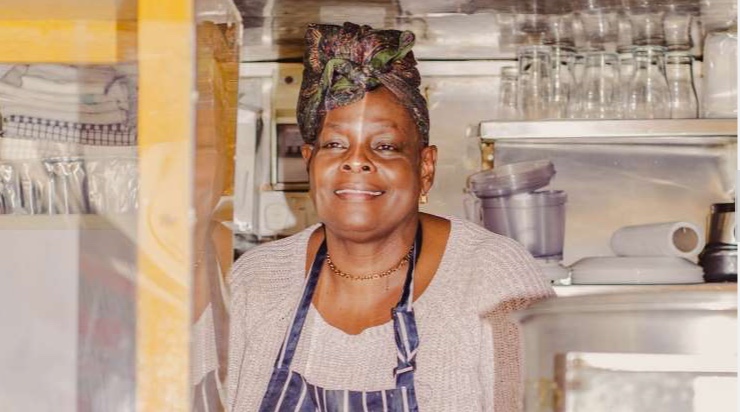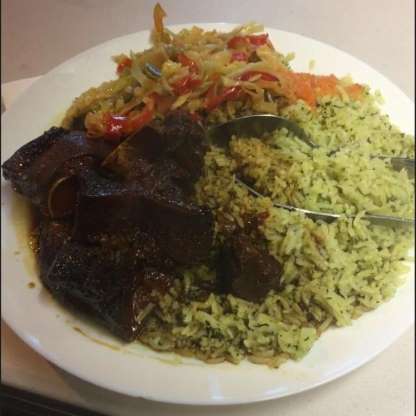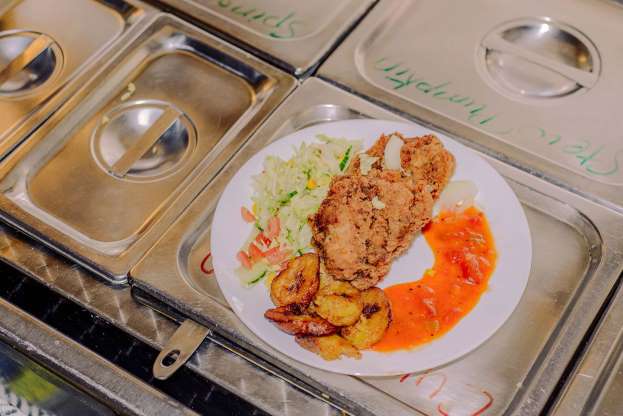On Monday evening as the shopping centre sits silent, down in the moat — Elephant and Castle’s mantle — things are just getting started. As the warble of Mighty Sparrow’s calypso sounds from the record stall, behind the closed doors of the cabin decked out in the green, red, and yellow isosceles triangles of the Guyana flag, Faye Gomes and her team are busy with the week’s prep. Her assistant Sharon is doing the heavy work skillfully with a knife blade, the descaling of tranches of red bream which are thrown into a pot to soak in lemon juice. Eventually they will marinate overnight, fried on Tuesday, and only with the addition of green mango, okra, and potatoes will her fried fish curry be ready: either to wrapped in roti or soaked up with spinach rice.

“It’s the most delicious Caribbean food you can find,” she claims, not unjustifiably, in her native lilt, which stretches out vowels. “One, because we have more dishes than any other Caribbean country, but also because of the different people and because we are always creating something. Always.”
To understand the food of Guyana it is first necessary to understand the complex interactions of human beings and of colonialism that has left an indelible mark on the South American’s country’s food. Africans brought over as slaves, Indians and Chinese brought over as indentured workers to plug the gap left after slavery’s abolition, Portuguese from its island colonies, the European settlers who established British Guiana, and the indigenous tribes that make up the Amerindians. All of these influences and histories can be tasted in Gomes’ food: in her roti and dhal, in her rice and peas and fried fish, in her chow-mein, and in her slow-cooked pepper pot.
Originally Kaieteur Kitchen wasn’t going to be only Guyanese. Gomes used to head up the kitchen at the Commonwealth Secretariat’s canteen on Pall Mall, and it was there that she used her skills taken from Guyana’s multifaceted cuisine to cook the gamut of food from countries marked by British colonisation. Monday was British day with fish and chips and roast chicken, but she could run riot on African, Indian, or Caribbean day. Best of all, though, were the evening social clubs where snacks might be bake and saltfish, fried chicken, black pudding, or her chicken foot souse. People soon got word and soon the canteen filled up with workers from the surrounding offices, from as far as across the river at St Thomas’s Hospital. When the canteen closed, Gomes wanted to bring this jack-of-all-trades concept to Elephant but there was an immediate problem.

It’s these rices that form the backbone of Gomes’ cooking: cook-up rice made with leftover meats and warmed in coconut milk; power rice made fortified with vegetables and pulses; and her favourite, spinach rice, where the leaves have been blended and integrated to paint every grain green. But to explain why Gomes’ food is so special, lets paraphrase former Manchester United goalkeeper, Peter Schmeichel. Paul Scholes, Schmeichel said, was a great player not because of his highs, but because he had a high ‘bottom level’, even his weakest game would not register as a bad performance. Gomes has the highest ‘bottom level’ of any street food vendor in London. Her everyday dishes — her meatballs, her chicken curry, her spinach — would compete with anyone else’s best. But to experience the best of her best, like the pepper pot, is to encounter an altogether different level — one that hits those who taste it like a 25-yard dipping volley, in-off the bar.
Gomes’ pepper pot is one of a few dishes in the Amerindian tradition — the secret to which she explains is cassareep, a molasses like liquid derived from the otherwise poisonous cassava root, that colours, flavours and preserves the pepper pot. Gomes cooks hers for two days, with oxtail, cow’s foot, tripe, orange peel and thyme, until the meat is as black and sticky as barbecue bark, with a phenomenal bitter-sweetness from both the cassareep and orange. Although it can be cooked further, at this point the oxtail simply falls from the bone, and the texture of the foot is like a pate de fruit, to be sucked on like grown-up wine gums. This is not just a dish, it’s something at the very soul of a cuisine, of a people.
“We’re resourceful,” Gomes explains. “Any Guyanese person who is a real cook, they can take nothing and turn it into something. It’s like the coconut, we use the entire coconut tree to create something. We take the coconut branch, we take the leaves, the roots to make a broom, we take the coconut shell to make earrings, the inside of the coconut we eat it, the coconut water we drink it, the sap. Every part of that coconut is used. We take things and change it, and that’s what we do with food.”
On a Friday when the pepper pot is on, along with specials like her black pudding and r garlic pork (to be ordered a week in advance) London’s Guyanese diaspora arrives to pay homage. Despite her love of introducing people to Guyanese cuisine, for Gomes this connection is vital: “It holds a lot of memories for people. People who have left Guyana have done so for so many years. There are many Guyanese who are born here and have never been back to Guyana to see their roots. They get excited when they come and see all this food here.”
But the divide in her customers isn’t between those who know Guyanese cuisine and those who don’t. It’s between those who fall in love with Gomes before or after they’ve eaten her food.The boundary between Gomes and what she cooks is so porous it barely exists, the food is an extension of her personality: earthy, generous, big-hearted. She expresses her love of people by feeding them, and people respond in kind. You see it in the customer interactions which can last last half an hour; in the way young boys call her aunty and pull on her heartstrings to land leftovers; the way the local homeless people talk about her, so often is she seen delivering heated tupperwares of stews around the station because she so believes in the dignity of a hot meal; in the way her entire shelving and painting was done by customers who only wanted her food in return; in the fact she still has customers that visited her canteen twenty years ago. She has fed celebrities (Luciano, the Jamaican singer was the last singer spotted sitting down on her plastic chairs to eat), and taken commissions from Baroness Amos and the Brighton football team, but it is the day-to-day relationships, ones nourished over so many years, that she is proud of.
Once the centre closes Gomes will move into the temporary structure on Elephant Square. She hopes this space will allow her to spruce things up and move her cooking to an even higher level. Her next task she says is to do extra cooks in the evening so she can feed those who need but can’t afford it.
And then?
“I hope to have a very massive restaurant one day, if not here then in Guyana. Somewhere in a big city or on a main street. But it will always be cooking. Even when I’m feeling down and I leave home and I come out here, my spirits have been lifted: one because of the customers, two because when people eat my food and say ‘I enjoy it, it’s beautiful, thank you’ I do feel different and lifted.”
She shakes as she laughs yet again, a huge laugh. “This is my passion! This is my big passion.”











